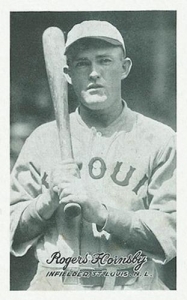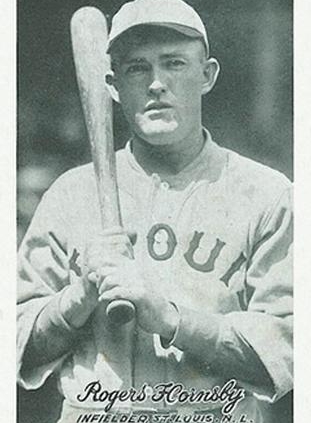July 19, 1922: Fans hoist Rogers Hornsby to their shoulders after his game-winning home run
 The St. Louis Cardinals were surging. On June 30 St. Louis had trailed the first-place and defending World Series champion New York Giants by 5½ games, but the Cardinals had won three of four games against the Giants at Sportsman’s Park from July 15 to July 18 to cut the lead to a half-game.
The St. Louis Cardinals were surging. On June 30 St. Louis had trailed the first-place and defending World Series champion New York Giants by 5½ games, but the Cardinals had won three of four games against the Giants at Sportsman’s Park from July 15 to July 18 to cut the lead to a half-game.
St. Louis was enjoying a 13-5 record on its homestand and hosting the eighth-place Boston Braves for five games before departing for a rematch with the Giants in New York. Despite Boston’s lowly status, it could boast of a 7-1 record against the Cardinals, having won four straight at St. Louis in May and three of four at Braves Field in June. The St. Louis Post-Dispatch had dubbed it a Boston “jinx.”1
If indeed there was a jinx, 18,000 “Tuberculosis Day” fans witnessed its end on July 19 at the hands of Rogers Hornsby.2
The Cardinals sent Jesse Haines (6-4) to the mound, hoping he would fare better than he had in May, when he threw two shaky innings of relief against the Braves, yielding four hits, two walks, and two runs. In his most recent assignment, on July 15, Haines had topped the Giants.
Boston countered with right-handed Frank Miller. He had won his first six decisions, including a win over St. Louis, but had lost four consecutive starts since beating the Chicago Cubs on June 17.
Haines threw a one-two-three first, featuring strikeouts of Ray Powell and Walton Cruise. But Miller was in trouble almost as soon as he toed the rubber. Max Flack ripped a double, and Jack Smith waited out a walk, bringing Hornsby to the plate.
Hornsby had been unstoppable during the current homestand. In 18 games he had 29 hits – including seven doubles, a triple, and six home runs – and 23 runs batted in. Just past the season’s halfway mark, Hornsby had already tied the post-1900 NL single-season home-run record (24), set by Gavvy Cravath in 1915.
Hornsby – hitting .394 to lead the National League – doubled, scoring Flack and sending Smith to third. With Hornsby at second, Smith on third, and no one out, Heinie Mueller hit sharply to Boston shortstop Larry Kopf, who fired to first baseman Walter Holke for the putout.
Hornsby dashed for third when Kopf made the throw, but Smith had not vacated the base. Holke spotted the dilemma and ran toward third with the ball, prompting Smith to head for home. Holke pivoted and tossed the ball to catcher Mickey O’Neil, who tagged Smith several feet in front of home plate to complete a double play.
With two outs and Hornsby at third, Jack Fournier walked to extend the rally, but Milt Smith grounded out, Kopf to Holke, ending the inning with just one St. Louis run.
Boston tied the game in the second on O’Neil’s two-out single to left that scored Holke from second base, and the Braves jumped on top in the third, 2-1, on Powell’s leadoff home run into the right-field seats. The next two Boston batters reached base on a single and an error, and it looked as though the Braves would have a big inning. Instead, the attack fizzled. Holke’s foul out to the catcher and Hod Ford’s groundout prevented further scoring.
Boston’s lead disappeared in the sixth when the Cardinals raked Miller for three hits and three runs. Flack sparked the rally by walking; he moved to second on Smith’s single to left. After Hornsby fouled out, Mueller hit a bounding ball over second base to score Flack with the tying run, as Smith moved to third. Fournier stroked a single to right, scoring Smith, and sending Mueller to third. Mueller scored on Milt Stock’s fly to deep right, putting St. Louis ahead, 4-2.
Haines retired 15 Braves in a row from the third inning through the seventh, so it appeared that the Cardinals’ two-run margin would carry the day. It did not. The Braves erupted for four runs in the eighth, turning the tables and driving Haines from the game.
The inning began with back-to-back singles from Powell and Al Nixon, putting Braves on first and third. Cruise popped up a bunt for the first out, but Tony Boeckel dribbled a grounder down the third-base line for a single to fill the bases.
Holke’s single to left scored Powell and Nixon, tying the game. Ford’s single scored Boeckel, giving Boston a 5-4 edge, and Holke scored the fourth run of the inning on Kopf’s single to center.
It took an unconventional double play to prevent an even bigger outburst. When Ford attempted to take third on Kopf’s hit, center fielder Smith scooped up the ball and fired to third in time to cut him down. After tagging Ford, third baseman Stock rocketed the ball to Hornsby, who slapped it on Kopf before he reached second. The double play ended the inning, but Boston was up, 6-4.
St. Louis placed runners on first and third in the eighth but failed to score, and the Cardinals took the field for the top of the ninth trailing by two. Lou North replaced Haines on the mound. He fanned O’Neil and Miller, and fielded Powell’s grounder, throwing to Fournier for the third out.
With the Cardinals three outs from defeat, Joe Schultz pinch-hit for shortstop Doc Lavan to begin the St. Louis ninth, and singled; Les Mann ran for Schultz. Burt Shotton, batting for pitcher North, hit a bullet to right field. Cruise made a nice running catch, and Mann scrambled back to first.
Flack followed with a drive to deep right-center; Cruise raced to the wall, made another running catch, and Mann reversed course to first.
With two out, the outfielders played deeper than usual to prevent an extra-base hit. Smith looped a ball just over the infield for a single, and Mann sprinted safely to third.
Hornsby stepped to the plate with the Cardinals down to their final out and two runners aboard. Miller’s first pitch was a high fastball, and Hornsby launched it on an arc toward the right-center-field bleachers.
Cruise, and center fielder Powell, retreated to the wall with their gloves at the ready. The ball dropped just over the wire screen atop the bleacher wall, and into the stands. Two feet shorter and it would have settled into an outfielder’s glove.3
Mann and Smith raced across home plate to tie the game. As Hornsby trotted around the bases, hundreds of fans “dashed out madly”4 from the grandstands, impeding his way. Hornsby “broke through their ranks to record the decisive run.”5 After touching home plate, he sought to escape the exuberant throng, “but was hoisted upon their shoulders and carried to the clubhouse.”6
North was the winning pitcher; his one perfect inning of relief raised his record to 5-1. Miller dropped to 6-5, and despite the season’s promising start, he ended 1922 at 11-13.
For the second time in less than two weeks Hornsby had homered in the ninth to bring St. Louis victory. He walloped a walk-off on July 7, when his two-run homer in the ninth beat Dazzy Vance and the Brooklyn Robins, 6-5. (Of course, Hornsby’s home run against Boston is more accurately called a “carry-off!”)
The 7-6 win kept the Cardinals on pace with the Giants, who beat Cincinnati, 5-2. St. Louis won the next three games of the Boston series before losing the finale, 4-1. That loss left the Cardinals with a 57-36 record, and they opened the series at the Polo Grounds on July 25 trailing the Giants (54-34) by one percentage point.
Things did not go well in New York for the Cardinals; the Giants won four of the five games. Nevertheless, St. Louis occupied the top rung of the NL as late as August 11, only to fade to a third-place tie with Pittsburgh (85-69), behind Cincinnati (86-68) and New York (93-61).
By season’s end, Boston had lost 100 games (53-100) and mired in last place, were 39½ games out of first and four games behind the seventh-place Phillies. Boston had won its first seven games against St. Louis, but the season series ended 11-11. It was Boston’s best performance against any NL team.
Although St. Louis faltered down the stretch, Hornsby did not. He hit safely in 33 consecutive games from August 13 to September 19,7 and he rapped seven hits in his final 12 at-bats of the season to raise his batting average from .398 to .401 – becoming the first NL batter to hit .400 or better in the twentieth century.
Hornsby achieved the Triple Crown (leading the league in batting, home runs, and runs batted in), and established six National League records: hits (250), doubles (46), home runs (42), RBIs (152), total bases (450), and slugging percentage (.722).8 Hornsby also led the NL in runs scored (141), batting, and on-base percentage (.459). Applying modern metrics, Hornsby reached an OPS of 1.181, and bWAR of 10.1, and those figures topped the league as well.
Acknowledgments
This article was fact-checked by Kevin Larkin and copy-edited by Len Levin. The author also wishes to acknowledge the late Paul Warburton, whose article, “Rogers Hornsby – Sure Modern Offense Is Great, but Let’s Not Forget This Guy,” Baseball Research Journal, No. 28 (1999): 3-7, brought this game to my attention.
Sources
In addition to the Sources cited in the Notes, the author consulted the Baseball-Reference.com and Retrosheet.org websites for pertinent material and the box scores noted below, and obtained game-day information and descriptions of the play-by-play from newspapers listed in the notes.
https://www.baseball-reference.com/boxes/SLN/SLN192207190.shtml
https://www.retrosheet.org/boxesetc/1922/B07190SLN1922.htm
Notes
1 Joseph F. Holland, “Hornsby’s 25th Home Run, with Two On and Two Down in the Ninth, Beats Braves,” St. Louis Post-Dispatch, July 20, 1922: 24.
2 Tuberculosis Day was an annual event to benefit the Tuberculosis Society in St. Louis. It included parades and fundraising activities and culminated with a Cardinals game at Sportsman’s Park. “Matty Signs Set of Balls for Tuberculosis Day,” St. Louis Star, July 17, 1921: 8.
3 Holland.
4 John J. Sheridan, “Wallops His 25th for Season and Shatters National League Mark,” St. Louis Globe-Democrat, July 20, 1922: 16.
5 Holland.
6 Holland.
7 For more information on Hornsby’s 1922 season, see Paul Warburton, “Rogers Hornsby – Sure Modern Offense Is Great, but Let’s Not Forget This Guy,” SABR Baseball Research Journal, No. 28 (1999): 3-7.
8 Scott Nelson, “Seasonal Records – As They Were Set,” Baseball Research Journal, No. 28 (1999): 84-87.
Additional Stats
St. Louis Cardinals 7
Boston Braves 6
Sportsman’s Park
St. Louis, MO
Box Score + PBP:
Corrections? Additions?
If you can help us improve this game story, contact us.


